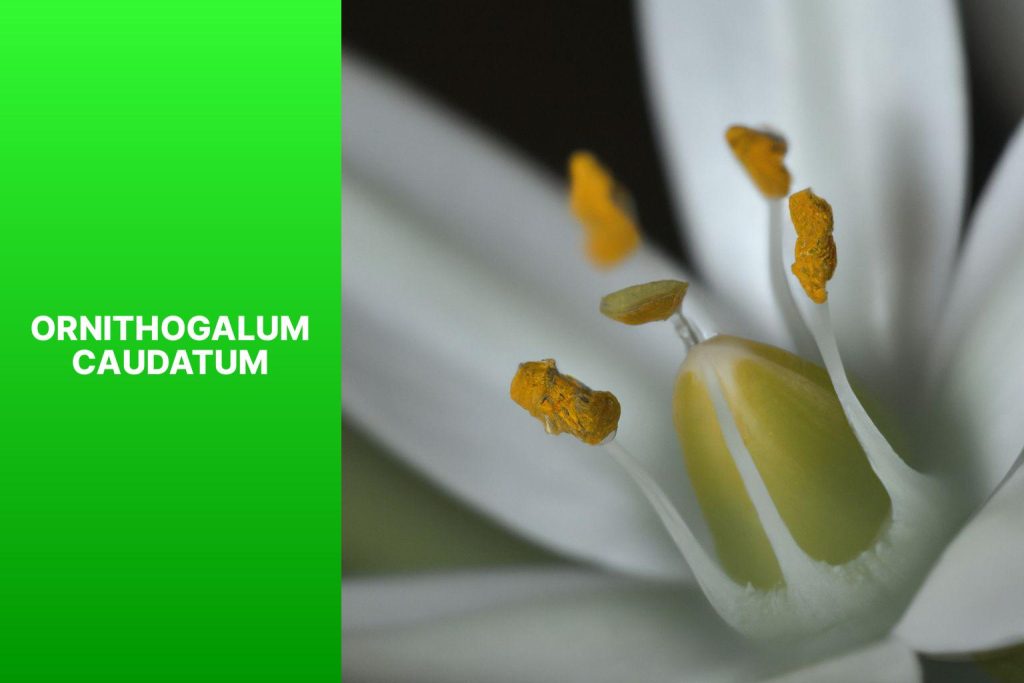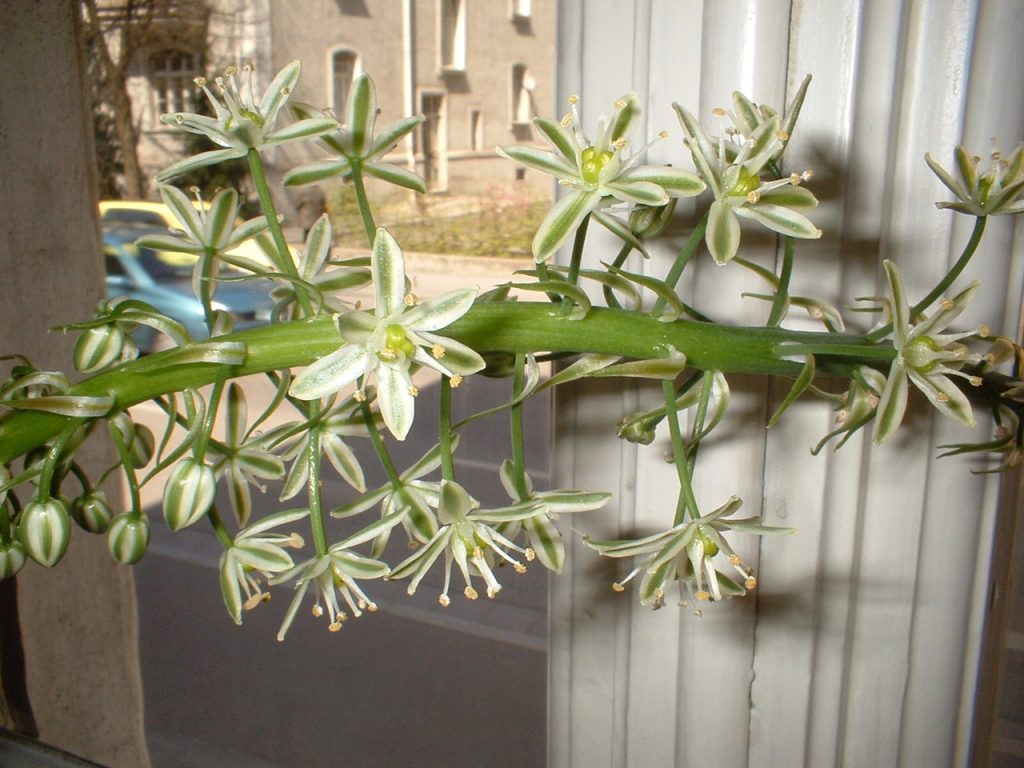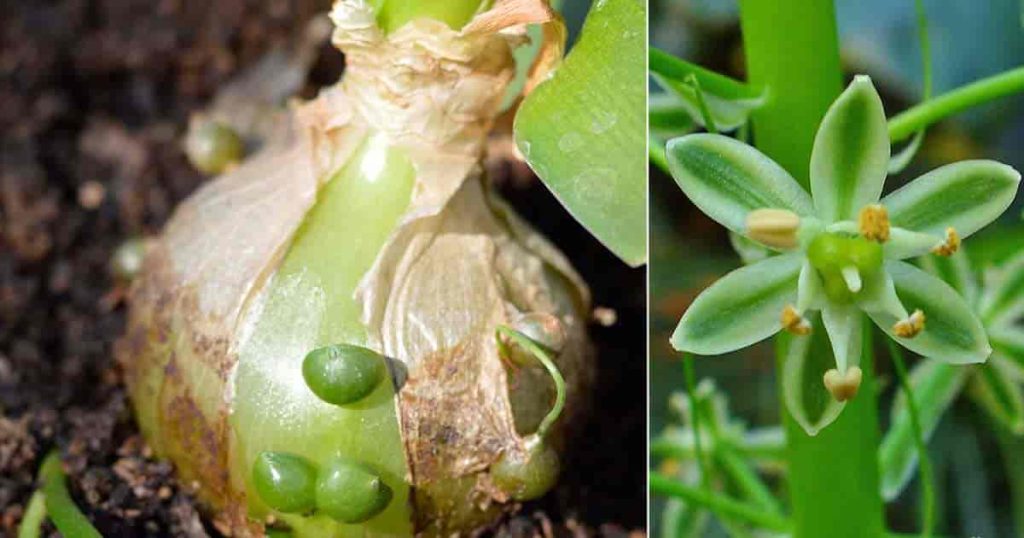Ornithogalum caudatum, also known as the “False Sea Onion” or “Pregnant Onion”, is a bulbous plant native to South Africa. It is a member of the Hyacinthaceae family, which also includes daffodils and lilies.

Characteristics Of The Ornithogalum Caudatum Plant
Ornithogalum Caudatum is a hardy plant that can tolerate a wide range of temperatures. It prefers full sun or partial shade and well-drained soil. The plant produces long, strap-like leaves that can grow up to 3 feet long. In the spring, it produces a tall spike of white flowers with green stripes.
The common name “Pregnant Onion” comes from the fact that the plant produces small bulblets on the sides of the main bulb. These bullets can be planted to propagate new plants.
Table of Contents
Despite the common name, Ornithogalum Caudatum is not edible. All parts of the plant are poisonous to humans and animals.
The flowers are white with green stripes. They are small, about 1 inch in diameter, and they are arranged in a spike that can grow up to 3 feet tall. The flowers have a light, pleasant scent.
Here are some additional facts about Ornithogalum Caudatum:
- The plant blooms in the spring or summer, depending on the climate.
- The flowers are fragrant and attract bees and butterflies.
- The plant is drought-tolerant and can survive in hot, dry climates.
- Ornithogalum Caudatum is a popular ornamental plant and is often grown in gardens.
If you are considering growing Ornithogalum Caudatum, it is important to be aware of its poisonous properties. Keep the plant out of reach of children and pets.
Caring For Ornithogalum Caudatum Sprouts
Ornithogalum caudatum, also known as the “False Sea Onion” or “Pregnant Onion”, is a relatively easy plant to care for. Here are some tips for growing Ornithogalum Caudatum:
- Light: Ornithogalum Caudatum prefers full sun or partial shade. Too much shade will cause the leaves to become yellow, and the plant may not bloom.
- Water: The plant needs regular watering, but the soil should not be soggy. Allow the soil to dry out between waterings.
- Soil: The plant prefers well-drained soil. A cactus mix or a potting mix with added sand or perlite will work well.
- Fertilizer: The plant does not need to be fertilized often. A light application of fertilizer in the spring will help the plant bloom.
- Pests and diseases: Ornithogalum Caudatum is relatively resistant to pests and diseases. However, it may be susceptible to mealybugs and scale. If you see any pests, you can treat them with insecticidal soap or neem oil.
Here are some additional tips for growing Ornithogalum Caudatum:
- Planting: Plant the bulbs in the spring in a sunny spot. The bulbs should be planted about 2 inches deep and 6 inches apart.
- Overwintering: If you live in a cold climate, you will need to overwinter the bulbs indoors. The bulbs can be stored in a cool, dry place.
- Propagation: Ornithogalum Caudatum can be propagated from seed or from bulblets. Bulblets are small bulbs that form on the sides of the main bulb. To propagate from bulblets, simply plant them in a pot of well-drained soil.
With proper care, Ornithogalum Caudatum will thrive and bloom for many years.
Here are some additional details about growing Ornithogalum Caudatum:
- Hardiness: Ornithogalum Caudatum is hardy in USDA zones 7–10. In colder climates, the bulbs should be overwintered indoors.
- Bloom time: Ornithogalum Caudatum blooms in the spring or summer, depending on the climate.
- Height: Ornithogalum Caudatum can grow up to 3 feet tall.
- Propagation: Ornithogalum Caudatum can be propagated from seed or from bulblets.


Medical Uses Of Ornithogalum Caudatum From History to the Present
Ornithogalum caudatum, also known as the “False Sea Onion” or “Pregnant Onion”, has a long history of medicinal use in traditional African medicine. The plant is said to have a variety of medicinal properties, including:
- Anti-inflammatory: The leaves of Ornithogalum caudatum are said to be effective in reducing inflammation. This property has been attributed to the plant’s high content of antioxidants.
- Antibacterial: The plant has also been shown to have antibacterial properties. This property may be useful in treating infections.
- Antifungal: Ornithogalum caudatum has also been shown to have antifungal properties. This property may be useful in treating fungal infections such as athlete’s foot.
- Astringent: The plant has astringent properties, which means that it can help tighten tissues. This property may be useful in treating diarrhea and other conditions that cause loose stools.
- Diuretic: The plant is also a diuretic, which means that it can help increase urine production. This property may be useful in treating edema and other conditions that are associated with fluid retention.
However, it is important to note that there is limited scientific evidence to support the medicinal claims of Ornithogalum caudatum. More research is needed to determine the safety and efficacy of the plant for medicinal purposes.
It is also important to note that all parts of Ornithogalum caudatum are poisonous, so they should not be ingested. If you are considering using Ornithogalum caudatum for medicinal purposes, it is important to consult with a healthcare professional.
Damages And Symptoms Of Ornithogalum Caudatum
Ornithogalum caudatum, also known as the “False Sea Onion” or “Pregnant Onion”, is a poisonous plant. All parts of the plant, including the bulbs, leaves, flowers, and sap, contain toxic compounds.
The toxicity of Ornithogalum Caudatum is due to the presence of oxalic acid and other oxalates. Oxalates are naturally occurring compounds that can be found in many plants. However, in Ornithogalum Caudatum, the levels of oxalates are very high.
Ingestion of Ornithogalum Caudatum can cause a variety of symptoms, including:
- Nausea
- Vomiting
- Diarrhea
- Abdominal pain
- Dizziness
- Confusion
- Seizures
- Coma
In severe cases, ingestion of Ornithogalum Caudatum can be fatal.
If you think that you or someone you know has ingested Ornithogalum Caudatum, it is important to seek medical attention immediately. There is no specific antidote for Ornithogalum Caudatum poisoning, but treatment is supportive and may include activated charcoal, gastric lavage, and symptomatic care.
It is also important to note that Ornithogalum Caudatum can be harmful to pets. If you have pets, it is important to keep them away from the plant.
Here are some tips to prevent Ornithogalum cadatum poisoning:
- Do not ingest any part of the plant.
- Keep the plant out of reach of children and pets.
- If you are unsure whether a plant is poisonous, do not touch it.
If you have any questions about the toxicity of Ornithogalum Caudatum, you should consult with a healthcare professional.
1 thought on “ornithogalum caudatum”